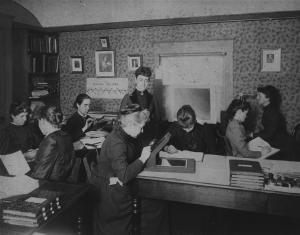Blog
After the Ecstasy,
the Laundry
4 December 2013
 Harvard College Observatory. Public Domain
Harvard College Observatory. Public DomainOften in science we talk about the latest sexy findings. The discovery of the Higgs boson, the minute by minute coverage of comet ISON, the most Earth-like planet around another star. Given all that attention, you might imagine that as an astrophysicist I spend my days playing with multi-million dollar space telescopes. What I actually do is analyze data and work on computational models (along with teaching, grading and other professorial stuff). It isn’t remotely sexy. Interesting and fulfilling, but not sexy.
One of the challenges in astronomy is analyzing data. Earlier astronomers gathered and analyzed their data on their own, but with the rise of photographic astronomy it became easier to gather far more observations than could be analyzed by a single person. Many observatories started utilizing “computers” to analyze the data, typically women who would do the tedious work for little or no pay.
Perhaps the most famous women computers were the Harvard College Observatory team (pictured above) lead by Edward Pickering. They were often referred to as “Pickering’s Harem.” Analyzing photographic plates by hand is tedious work, but it led to new discoveries. For example, one of Pickering’s computers was Henrietta Leavitt, who analyzed more than 1700 variable stars to discover the luminosity-period relation for Cepheid variables. Using this relation, Edwin Hubble was able to measure the distance of galaxies, and eventually demonstrated that the universe is expanding. Hubble’s sexy result is remembered more than Leavitt’s tedious work.
In modern astronomy we face a similar challenge. Multi-million dollar telescopes gather mountains of data, which can lead to cool new discoveries, but all that data has to be analyzed. As a recent editorial in Nature points out,1 sometimes the data can’t be analyzed because the background work hasn’t been done. The Sloan digital sky survey analyzes 1800 stellar spectra a night, but many of the spectral lines are unanalyzed because we don’t have enough lab data on atomic spectra. What is needed is lab analysis of line spectra, but that kind of work is tedious, and not very sexy. But like Leavitt’s work on variable stars, it could lead to radical new discoveries about things like dark matter and the origin of our galaxy.
It’s easy to focus on the big results in science, but it’s important to keep in mind how much scientific work it takes to allow those big discoveries to happen.
Atkins, J. F., and P. V. Baranov. “Nailing fingerprints in the stars.” Nature (2013): 437-437. ↩︎